Conflict on the rise
Zuthunglo Patton, district forest officer, Wokha, has informed that human-elephant conflict in the area is on the rise and increasing every year, says a report in the Dimapur-based Morung Express. According to the nationwide “Synchronised Elephant Population Estimation 2017” study by the Union ministry of environment, forests and climate change, Nagaland has an elephant population of 446 and elephant density/km² of 0.45, which is the second highest after Karnataka.
Advertisement
Due to increasing reports of incidences of human-elephant conflict, a joint assessment was carried out in April by the district level committee for assessment of the loss of human life, domestic animals, crops and properties by wild animals for compensation.
It showed that this year alone, 165 families belonging to eight villages of New Changsu, Ekhoyan, Old and New Riphyim, Wokha village, New Wokha, Seleku and Koio were badly affected by the presence of elephants. The crops or property damaged were paddy, banana, pineapple, orange, sugarcane, vegetables, yongchak, betel nut, rubber, papaya, jackfruit, granary, farm huts, piggery, poultry, et al, amounting to more than Rs 17 lakh, which could only be partially reimbursed by the wildlife wing of the forest department this year.
The most recent reports of human-elephant conflict in June is from the villages of Old Riphyim, New Riphyim, Old Changsu and Mungya affecting 97 farmers and the GMS building at Mungya, which have been verified by the department, it added.
Restoring heritage
The North East Regional Centre of the Indira Gandhi National Centre for Arts and the Guwahati-based conservation body, Heritage Conservation Society of Assam have identified several areas for mutual cooperation and collaboration like setting up a research centre for conservation, restoration and digitisation of the old manuscripts of the state. A press release issued by the HeCSA said that besides taking up joint collaborative projects, it would extend all necessary local support to the IGNCA in carrying out its activities, according to a report in the Guwahati-based Assam Tribune.
The HeCSA has already signed a MoU with the KK Handiqui Government Sanskrit College, Guwahati, to develop infrastructure and run the administration of the research centre. The HeCSA, a non-profit organisation working in the areas of preservation and conservation of tangible and intangible heritage of Assam, has also prepared a project named “Nabin Tan-Man Bikash Yojana”. It has been submitted to the state government for implementation in schools as part of their curriculum for the mental and physical development of children.
It has so far restored the century-old structure of Christ Church at Panbazar in Guwahati (pictured above), the 100-year-old Chemistry Building of Cotton University, residential bungalow of the Cotton College Principal, the new Arts Building of Cotton University and the historic North Brook Gate at Sukreswarghat, said the press release.
Nod for excellence
Oyi Tamut was awarded the “best international speaker” award for her paper presentation at the 20th International Linguistic Congress held in Cape Town, South Africa recently, says a report in the Itanagar-based Arunachal Times.
The ILC is held once every five years to showcase current developments in linguists across the world. This year, scholars from 32 countries participated in the conference, and Tamut was the sole recipient of the coveted award.
A native of Jomo village in Siang district, Arunachal Pradesh, Tamut graduated from the prestigious Women’s College in Shillong, Meghalaya, with distinction and is currently pursuing her PhD in linguistics from the North Eastern Hill University, Shillong.











